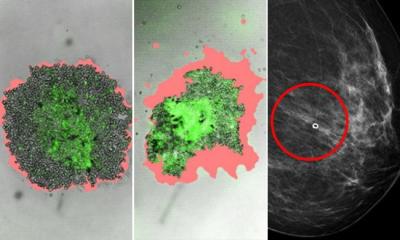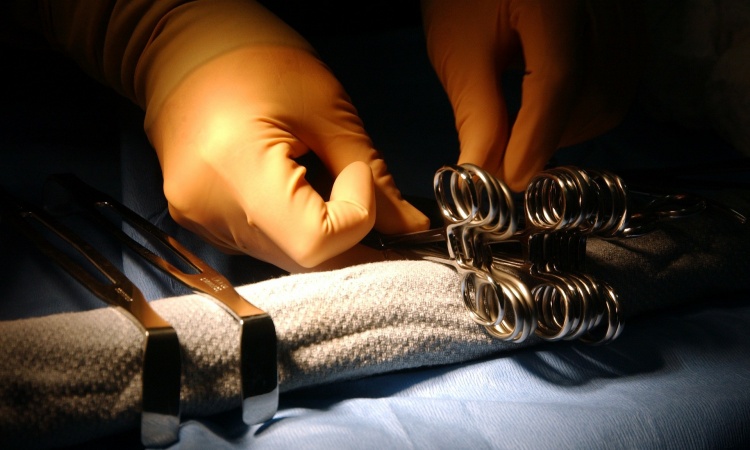
Image source: Garvan Institute of Medical Research
News • Classifying subtypes
Breast cancer ‘ecotypes’ could lead to more personalised treatment
A team led by the Garvan Institute of Medical Research has revealed a new approach for classifying breast cancer subtypes based on their cell profile, which could help personalise treatments for patients.
By analysing breast cancer biopsies from patients at Sydney hospitals, the researchers revealed more than 50 distinct cancer, immune and connective cell types and states, which could assign breast cancers to one of nine cancer ‘ecotypes’, each of which was associated with a different cancer prognosis. “Our research has uncovered a cellular model for how we group cancers, which may be a powerful method to help personalise breast cancer treatments,” says Associate Professor Alex Swarbrick, Head of the Tumour Progression Lab at Garvan and senior author of the paper published in Nature Genetics.
Each of these ecotypes directly corresponded with a different clinical outcome in patients, which is why we think they may help reveal which treatment a tumour will best respond to
Daniel Roden
The team is now aiming to develop a clinical test that will ‘ecotype’ cancers to determine which treatment is best suited to which patient. “Tumours are not made up of a single cell type, but rather a complex mix of cancer, immune and connective tissue cells, that all play a role in tumour progression and prognosis. Our new ecotyping approach for stratifying breast cancers based on all the individual cells they contain may inform therapy strategies that improve outcomes for patients.”
Breast cancers are currently classified into three clinical subtypes (luminal, HER2+ and triple negative), based on specific receptors they do or do not produce. While these subtypes are used to estimate prognosis and guide treatments, not all breast cancers respond to this strategy, with the disease still claiming 3000 lives in Australia alone each year. “Current methods for classifying breast cancers only provide a limited picture of the complex biology contained in the tumours. Classifying breast cancers based on their entire composition of cells can provide a new and comprehensive view of a cancer. We wanted to develop an accessible framework for this,” says Sunny Wu, co-first author of the study.
Using cellular and spatial genomics technologies, which analyse individual cells and map their location within a tissue sample, the researchers assessed breast cancer biopsies from 26 patients at Sydney hospitals, including from St Vincent’s Hospital Sydney and The Chris O’Brien Lifehouse. These samples were analysed in the Garvan-Weizmann Centre for Cellular Genomics. “We looked at the complete cell profile of each breast cancer sample and revealed more than 50 different cell types or cell states that were present. We then analysed publicly available data from thousands of breast cancer patients and by assigning the new cell types and states discovered nine recurring patterns, which we define as ‘ecotypes’,” says Ghamdan Al-Eryani, co-first author of the study. “Each of these ecotypes directly corresponded with a different clinical outcome in patients, which is why we think they may help reveal which treatment a tumour will best respond to,” adds co-first author Dr Daniel Roden.
The Garvan team will next explore how their ecotyping method could be introduced in a clinical diagnostics pipeline, as a predictive test for personalised treatment. “One thing that is characteristic about each ecotype is their profile of immune cells. We expect that this would relate to a cancer’s response to immunotherapy, and identify patients that could benefit from this treatment,” says Associate Professor Swarbrick. “For instance, we found one breast cancer ecotype that uniquely has a high number of infiltrating lymphocytes, which are the target of current immunotherapies, and low levels of cells that we know to suppress lymphocytes. We would predict that those patients would respond well to immunotherapy, which is highly effective in some cancers, such as melanoma or lung cancer, but has a response of less than 10% in breast cancer patients. This study has shown us how crucial the complete cellular profile of tumours is to advancing breast cancer research aimed at personalised treatments.”
The data generated during this study is publicly available to researchers and forms part of the Breast Cancer Cell Atlas, an ambitious project to catalogue a million individual cells from 200 patient breast tumours and provide the most comprehensive cellular view of breast cancer yet.
Source: Garvan Institute of Medical Research
14.09.2021











